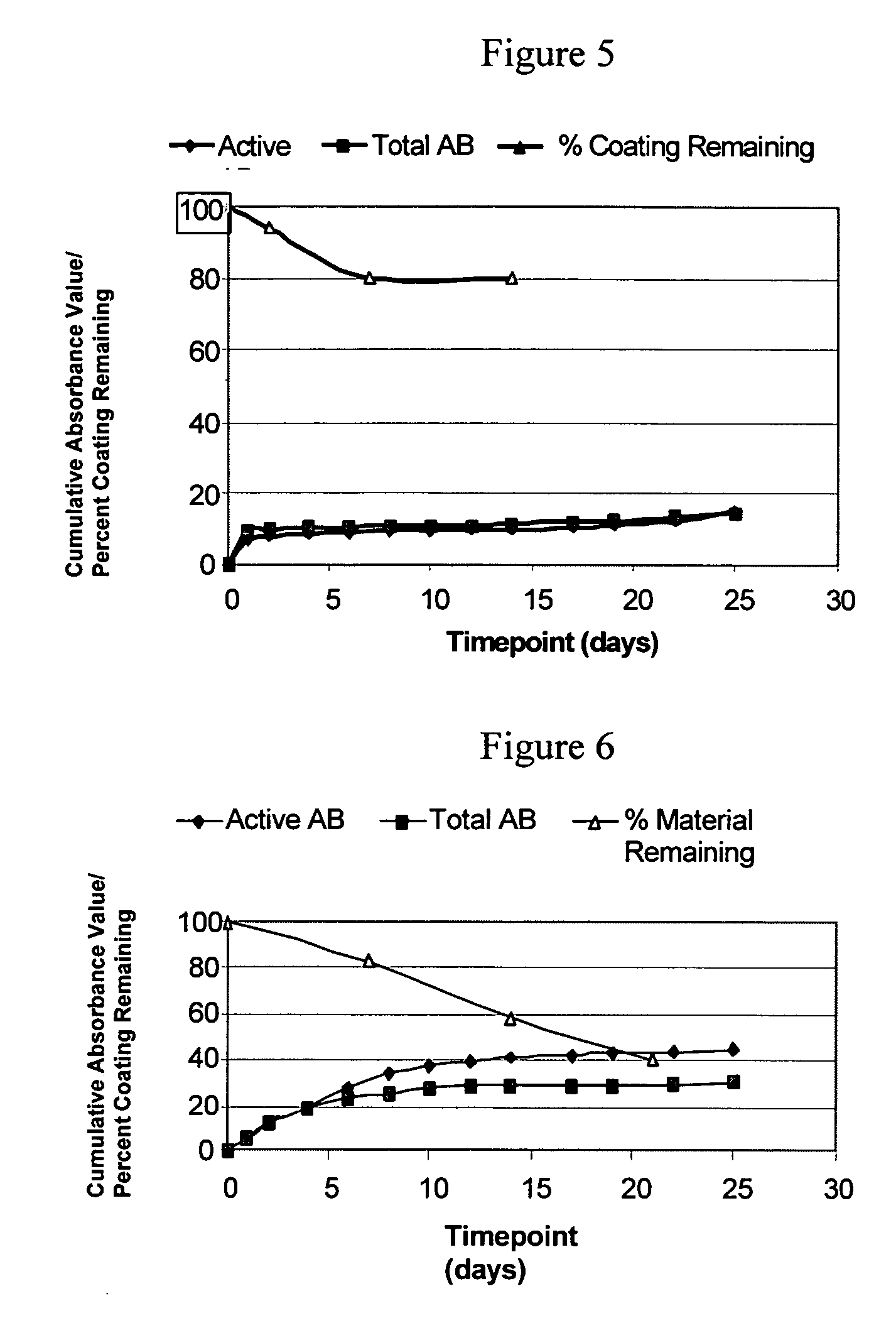Coatings including natural biodegradable polysaccharides and uses thereof
- Summary
- Abstract
- Description
- Claims
- Application Information
AI Technical Summary
Benefits of technology
Problems solved by technology
Method used
Image
Examples
example 1
Synthesis of Acrylated-Amylose
[0289] Amylose having polymerizable vinyl groups was prepared by mixing 0.75 g of amylose (A0512; Aldrich) with 100 mL of methylsulfoxide (JT Baker) in a 250 mL amber vial, with stirring. After one hour, 2 mL of triethylamine (TEA; Aldrich) was added and the mixture was allowed to stir for 5 minutes at room temperature. Subsequently, 2 mL of glycidyl acrylate (Polysciences) was added and the amylose and glycidyl acrylate were allowed to react by stirring overnight at room temperature. The mixture containing the amylose-glycidyl acrylate reaction product was dialyzed for 3 days against DI water using continuous flow dialysis. The resultant acrylated-amylose (0.50 g; 71.4% yield) was then lyophilized and stored desiccated at room temperature with protection from light.
example 2
Synthesis of MTA-PAAm
[0290] A polymerization initiator was prepared by copolymerizing a methacrylamide having a photoreactive group with acrylamide.
[0291] A methacrylamide-oxothioxanthene monomer (N-[3-(7-Methyl-9-oxothioxanthene-3-carboxamido)propyl]methacrylamide (MTA-APMA)) was first prepared. N-(3-aminopropyl)methacrylamide hydrochloride (APMA), 4.53 g (25.4 mmol), prepared as described in U.S. Pat. No. 5,858,653, Example 2, was suspended in 100 mL of anhydrous chloroform in a 250 mL round bottom flask equipped with a drying tube. 7-methyl-9-oxothioxanthene-3-carboxylic acid (MTA) was prepared as described in U.S. Pat. No. 4,506,083, Example D. MTA-chloride (MTA-Cl) was made as described in U.S. Pat. No. 6,007,833, Example 1. After cooling the slurry in an ice bath, MTA-Cl (7.69 g; 26.6 mmol) was added as a solid with stirring to the APMA-chloroform suspension. A solution of 7.42 mL (53.2 mmol) of TEA in 20 mL of chloroform was then added over a 1.5 hour time period, followed ...
example 3
Formation of an Amylose Coating
[0293] 100 mg of acrylated-amylose as prepared in Example 1 was placed in an 8 mL amber vial. To the acrylated-amylose was added 3 mg of MTA-PAAm (lyophilized), 2 μL of 2-NVP (N-vinyl-2-pyrrolidone; accelerant (Bimax)) and 1 mL of 1× phosphate-buffered saline (1×PBS). The reagents were then mixed for one hour on a shaker at 37° C. The mixture in an amount of 50 μL was placed onto a glass slide (2991FI; Esco) and illuminated for 50 seconds with an EFOS 100 SS illumination system equipped with a 400-500 nm filter (50 mW / cm2). After illumination the polymer was found to form a semi-firm gel having elastomeric properties.
PUM
| Property | Measurement | Unit |
|---|---|---|
| Thickness | aaaaa | aaaaa |
| Thickness | aaaaa | aaaaa |
| Mass | aaaaa | aaaaa |
Abstract
Description
Claims
Application Information
 Login to View More
Login to View More - R&D
- Intellectual Property
- Life Sciences
- Materials
- Tech Scout
- Unparalleled Data Quality
- Higher Quality Content
- 60% Fewer Hallucinations
Browse by: Latest US Patents, China's latest patents, Technical Efficacy Thesaurus, Application Domain, Technology Topic, Popular Technical Reports.
© 2025 PatSnap. All rights reserved.Legal|Privacy policy|Modern Slavery Act Transparency Statement|Sitemap|About US| Contact US: help@patsnap.com



